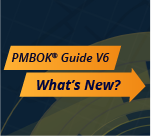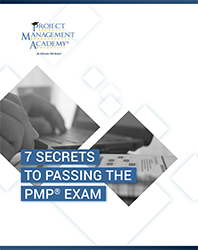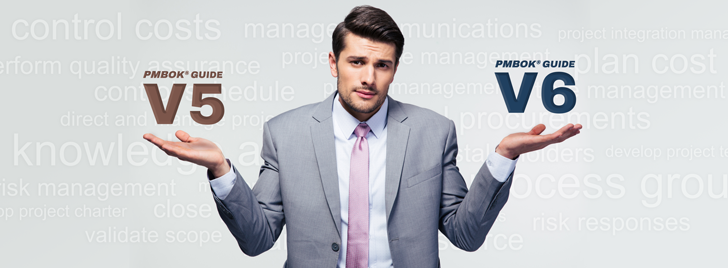
The Project Management Institute (PMI)® has released the newest version of A Guide to the Project Management Body of Knowledge (PMBOK® Guide).
While the PMBOK® Guide update contains the standard changes to knowledge areas, processes and ITTO, the latest version integrates agile, scrum and other iterative approaches for the first time and includes new chapters emphasizing the growing importance of leadership and business skills for the PMP credential holder.

7 Secrets to Passing the PMP Exam
Learn the secrets to passing the PMP® exam on your first try.
Project Management Academy® would like to provide a brief outline of the changes as well as the best way to keep your skills current.
When was the new PMBOK® Guide released?
Project Management Institute (PMI) released the new PMBOK® Guide - Sixth edition in September 2017.
When will the PMP® and CAPM® exams change based on the PMBOK® Guide - Sixth edition?
The PMP® exam changed on March 26, 2018. The Certified Associate in Project Management (CAPM)® changes in May of 2018.
Why is the PMBOK® Guide updated so often?
The PMBOK® Guide includes the Standard for Project Management, which is an accepted American National Standards Institute (ANSI) standard. As such, ANSI requires all standards undergo a review and an update as necessary every five to 10 years. Historically, PMI has updated the PMBOK® Guide every four years since 2009.
How much different is V6 from V5?

| Knowledge Area Name Changes: |
| Project Time Management becomes Project Schedule Management |
| Project Human Resource Management becomes Project Resource Management |
| Process Name Changes: |
| Perform Quality Assurance becomes Manage Quality |
| Plan Human Resource Management becomes Plan Resource Management |
| Control Communications becomes Monitor Communications |
| Control Risks becomes Monitor Risks |
| Plan Stakeholder Management becomes Plan Stakeholder Engagement |
| Control Stakeholder Engagement becomes Monitor Stakeholder Engagement |
| Acquire Project Team becomes Acquire Resources |
| Develop Project Team becomes Develop Team |
| Manage Project Team becomes Manage Team |
| Process count goes from 47 to 49 |
| Relocated/Merged Processes: |
| Estimate Activity Resources remains in the Planning Process Group, but changes to the Project Resource Management Knowledge Area |
| The Close Procurements process is absorbed by the Control Procurements process and the Close Project or Phase process |
| New Processes: |
| Manage Project Knowledge (KA: Project Integration Management - PG: Execution) |
| Control Project Resources (KA: Project Resource Management - PG: Monitor & Control) |
| Implement Risk Responses (KA: Project Risk Management - PG: Execution) |
ITTO Changes:
A significant area of change relates to the elements of the project management plan and project documents. These will be more visible as inputs/outputs, but have less emphasis:
On each process where the Project Management Plan is a key input, or where components of the plan are updated as part of that process, they will no longer be listed individually. The Project Management Plan will be listed as an input and Project Management Plan Updates will be listed as the output.
Similarly, Project Documents that are key to a process or that could be updated by a process, will simply have Project Documents listed as the input and Project Documents Updates listed as the output.
In the ITTO table for each individual process, where either of these are listed, there will be a listing of individual components of either the project management plan or specific project documents that could be used as inputs or that could be updated as an output of that process.
Additional information in each KA:
At the beginning of each KA, there are four sections that are key for a project manager’s understanding. These are labeled as Key Concepts, Tailoring Considerations, Trends and Emerging Practices, and Considerations for Agile/Adaptive Environments.
How will Agile, Scrum and other iterative approaches be integrated into the new version?
At the beginning of each of the KA, the iterative approaches and how they can interact is discussed. There is also an appendix added specifically to discuss these iterative concepts in the context of project management. When you purchase a copy of the PMBOK® Guide, it will come with a copy of the Agile Practice Guide.
Will there be any new chapters?
Yes, there is a new chapter related to the Role of the Project Manager. It covers the skills project managers should have to be successful, including leadership, business acumen, and influencing. This chapter includes a section covering the PMI Talent Triangle®. All project managers should be aware of the three key areas of skill to be successful, relevant and competitive:
- Technical
- Leadership
- Strategic/Business
What action should I take now?
PMA® offers a short course on the changes in the PMBOK® Guide, which covers these topics in more detail, and can be found
.In addition, as the new emphasis on leadership, business acumen, and influencing in the PMBOK® Guide - Sixth edition prove, keeping pace with the ever-changing business climate is more important than ever for PMP credential holders. Through its Club PDU, PMA® offers high-quality training to facilitate this. Find out more here.

 New Horizons
New Horizons
 Project Management Academy
Project Management Academy
 Six Sigma Online
Six Sigma Online
 TCM Security
TCM Security
 TRACOM
TRACOM
 Velopi
Velopi
 Watermark Learning
Watermark Learning
 Login
Login





 New Horizons
New Horizons
 Project Management Academy
Project Management Academy
 Velopi
Velopi
 Six Sigma Online
Six Sigma Online
 TCM Security
TCM Security
 TRACOM
TRACOM
 Watermark Learning
Watermark Learning